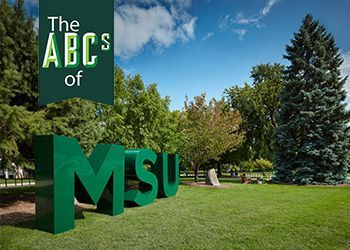Smart Money

By Paula Davenport
The greatest universities attract the best minds, the most revolutionary researchers and the finest students and teachers. And they need innovative laboratories, access to the latest technology and ultra-modern infrastructure.
Ka-ching. Ka-ching.
What’s a land-grant university to do? Take a page from Aristotle’s playbook: create endowed faculty positions.
Michigan State University is doing just that—with the generous backing of its benefactors. Since July 2011—the start of the Empower Extraordinary capital campaign—60 perpetually funded positions have been created at MSU. That brings MSU’s endowed faculty positions to 184.
When the campaign closes in 2018, MSU hopes to have secured an additional 40 endowed faculty appointments.
Endowed chairs are among the highest academic recognition bestowed on faculty. Chairs are star researchers with proven research records and established networks of collaborators, said June Youatt, MSU provost and vice president of academic affairs.
“These top-tier scholars help students find their life’s work, conduct groundbreaking research, attract grant funding to advance the university’s mission and give the university powerful means with which to (retain) and recruit future generations of MSU faculty,” Youatt said.
Funded Professorship Draws Microbiology Alum Back to Campus
By Paula Davenport
Microbiologist Victor J. DiRita, an MSU alumnus, taught classes and conducted research for 25 years as a University of Michigan faculty member. But he stayed true to his Spartan roots.
In fact, his car flaunted a hybrid Spartan vanity plate.
“It’s the block M with ‘SU 80’ (MSU 80), which is the year my wife and I graduated from Michigan State,” he said with a grin.
Today, DiRita and his license plate are back at MSU. In 2015, he was chosen to be MSU’s Rudolph Hugh Endowed Chair in Microbial Pathogenesis. He doubles as chairman of the university’s Department of Microbiology and Molecular Genetics—a shared department of the colleges of Veterinary Medicine, Human Medicine, Osteopathic Medicine and Natural Science.
And the license plate? It’s on the car his son—an MSU freshman—drives.
The new endowed professorship drew DiRita, a Detroit native, back to his alma mater. Today he’s an investigator and director of the very department in which he earned his bachelor’s degree.
His research strives to discover new methods and medicines to prevent and cure infectious diseases and illnesses—some of which are now antibiotic resistant. These ailments can stem from eating tainted chicken, being hospitalized or having to live in fetid, overcrowded conditions such as refugee camps.
Big problems. With big hopes.
DiRita said the Rudolph Hugh Endowed Chair carries bountiful resources—aimed at accelerating medical breakthroughs with potential to relieve human suffering.
That’s the way the late Hugh intended it to be. A Muskegon native, Hugh earned his bachelor’s in microbiology at MSU in 1948. Known for his bacterial identification skills, he was a microbiology professor at George Washington University for 35 years.
Prior to that, he worked at the forerunner of the Centers for Disease Control and Prevention, according to his 2011 obituary in The Washington Post. His planned gift to MSU established the chair in his name.
“The biggest thing for endowed chairs is the opportunity to expand research programs,” DiRita said.
It’s expensive to create science laboratories with revolutionary research capabilities—think rapid gene-sequencing machines and super-computers.
Attracting and hiring the brainiest graduate students and post-doctoral fellows takes significant financial resources that might not exist without the endowment, DiRita said.
“What really has to happen at universities is the discovery of new things in nature. The research is slow. It’s expensive. But it’s the predicate for (future) discoveries that are going to be beneficial to people,” he said.
Investing in Excellence
By Devon Barrett
Michigan State University hosted its first-ever university-wide endowed faculty investiture ceremony in late October. The MSU Investiture formally recognized faculty members appointed to endowed positions since July 1, 2011, the start of the Empower Extraordinary capital campaign.
Officiants included President Lou Anna K. Simon, Provost June Pierce Youatt and the MSU Board of Trustees. Alumnus and donor Al Gambrel spoke about how he became inspired to create an endowed position within the Eli Broad College of Business. Debra Furr-Holden, C.S. Mott Endowed Professor of Public Health, talked about the importance of endowed positions.
MSU bestowed 41 endowed faculty members with special medallions to symbolize their esteemed positions.
The ceremony also provided an opportunity for donors and foundation representatives to meet those holding the endowed positions they created.
An Interview with Victor J. DiRita
By Paula Davenport
MSU: What led you to your field?
DiRita: I had a microbiology professor at MSU, Robert Brubaker, who was fantastic. He was working on pathogenic bacteria, including the plague. I worked in his lab as an undergrad and the Gestalt of watching him searching for answers to his questions in a completely independent manner appealed to me. I liked the idea that I could make new discoveries in microbiology by asking new and different questions that I came up with. I enjoy that opportunity to reason things out and be creative…rather than following some recipe.
MSU: What is the focus and impact of your research?
DiRita: The fact that antibiotics are beginning to fail is a major public health threat. We’re looking for novel therapeutic treatments that are laser like—rather than atomic bombs (like so many of today’s antibiotics). Those broad-spectrum antibiotics may wipe out culprit bugs but they also destroy beneficial flora and fauna in the gut of someone who’s already very sick.
MSU: Tell us about an “aha” moment.
DiRita: For me, discovering something that’s never been known before—no matter how big or small the discovery is—like a drug, it’s euphoric. And I get this feeling that the next discovery will be even more exhilarating.
MSU: What sets you apart in your field?
DiRita: I remind myself that I am surrounded by a lot of very smart people. That’s a humbling and important realization that pushes me to be always on my game.
MSU: What makes you hopeful and/or happy?
DiRita: I’m hopeful about the work we’re doing to try to uncover novel approaches for preventing and treating infections. And at MSU, we scientists can more easily collaborate across disciplines to solve problems. My family and my new job make me happy.
MSU: What’s been on your mind lately?
DiRita: We’ve come to appreciate a lot more about how microbes contribute not just to disease but also to our health and our immune systems. That’s been a huge revolution in our thinking.
There are even voices in our field suggesting we get rid of the word “pathogen” because it’s misleading. It’s really just a microbe and it may be virulent in some circumstances—and non-virulent in others.
We’re really evolving our thinking and are trying to tease out differences in various microbes and how they function. It’s really the (biological) context in which microbes are living that determines whether they’re problems or not.
An Interview with Joan B. Rose
By Jana Eisenberg
MSU: What led you to your field?
Rose: I was fascinated by microbiology as soon as I looked down a microscope into this unseen biological world. That combined with my interest in the environment. For my master’s work I studied a bee disease new to the U.S. My first job (in a sewage treatment plant) led me to look at human microbes—how disease spreads through water.
MSU: What is the focus and impact of your research?
Rose: My research interfaces four areas. Constantly advancing technology allows us to study metagenomics, human genome and microbiome, and now the water biome. We can find things we never could before. We use a diagnostic approach to help solve problems. We combine that with engineering. For example, looking at how to implement waste-water treatment in places that don’t have any, like Brazil. Finally, there’s the link to policy, assessing risk, making sure that we’re spending money effectively. The impact is great—people are deeply connected to and care about their water. Obviously we need it to live: to drink and for our food systems. Many are connected to it spiritually, and/or via tourism and recreation.
MSU: Tell us about an “aha” moment.
Rose: When I finished my PhD, I studied a new pathogen, cryptosporidium. No one knew it was transmitted through water; I used a new method to prove it was. At first that was fun. But then there were U.S. outbreaks. People got sick, and died—from tap water. That made me realize that new pathogens would appear over and over. Having the ability to study them is really meaningful. We can share knowledge with engineers, policymakers and other scientists.
MSU: What sets you apart?
Rose: Having this MSU chair allows me to advance important things. One is working in the field. The second is translating research to help drive real public health benefits. The third is engaged research. At least a third of our portfolio involves collaborating with community or utilities—trying to answer their important, complex questions. The Nowlin Chair allows me to match dollars to enhance projects (and hence scientific research).
MSU: What makes you hopeful and/or happy?
Rose: People. My family—I have grandkids now. Students are an inspiration. They ask the new questions, bring new tools. They’re so excited. They understand the metagenomics work, I just recognize its importance. And my colleagues—they always help me learn something new.
MSU: What’s been on your mind lately?
Rose: After we found viruses in the ballast water of ships crossing the ocean from Singapore to Long Beach, I started thinking about the health of the planet—the land, plants, water, creatures and people—the “biohealth.” We are all connected.
An Interview with Eric Freedman
By Jana Eisenberg
MSU: What led you to your field?
Freedman: While in law school, I worked as congressional legislative and press aide. The reporters I met seemed to enjoy their jobs. When I graduated, I looked for both legal and reporting jobs. Fortunately, I was first offered a newspaper job. My early beats—covering courts, public and legal affairs, and city and state government—overlapped environmental issues.
MSU: What is your research focus and its impact?
Freedman: One is environmental journalism: how journalists and news organizations cover environmental issues, primarily in the former Soviet Union. My second is international journalists’ professional practices and education, constraints on press freedom and the role of press rights for advocacy (focused) non-governmental organizations.
These areas have wide impact. How can the public get fair, balanced, accurate and accessible information about environmental issues that confront every country, every community? And, press freedom and constraints go to the heart of democratic governance, citizen empowerment and transparency in institutions of power.
MSU: Tell us about an “aha” moment.
Freedman: I’d been reading and writing about journalists in repressive regions, talking about values like freedom of expression, speech and travel. Then, I met some journalists who, in addition to being censored or suppressed, had been arrested or assaulted because of their jobs—and learned that they continued to do their work, despite the personal risk. That was an “aha, this is real.”
MSU: What sets you apart?
Freedman: The MSU team at the Knight Center for Environmental Journalism, my colleagues in the School of Journalism and support from MSU International Studies and Programs are multipliers of any impact that my work has.
In addition, I continue to practice journalism, writing on topics that interest me, such as discrimination in higher education and Michigan politics and public affairs.
MSU: What makes you hopeful and/or happy?
Freedman: The continuing internationalization of our faculty and student body. MSU was founded primarily to provide practical education to farmers. Now it’s become a global university. The increase in international students and faculty exposes domestic students to some of the diverse range of experiences that they’ll be part of for the rest of their lives.
There are some really interesting folks who come to this campus. For example, we had a grad student who was an independent journalist in Cuba, until she incurred Fidel Castro’s wrath and was banned. And the Humphrey Program brings international economic specialists for professional internships. It’s exciting that during their year in Michigan, they gain a deep understanding of American culture and life, and take that back to their country.
The people we’re hiring and the influx of students adds to the richness of the university as a place to work and learn.
An Interview with Stephanie Valberg
By Jana Eisenberg
MSU: What led you to your field?
Valberg: I grew up in a “medical” family. I loved horses from the moment I saw one. I started riding lessons at six. I felt at home with horses—that we had a mutual understanding. I also love the sciences and mysteries—learning how the body works. Veterinary medicine put it all together.
MSU: What is the focus and impact of your research?
Valberg: My continued focus is perfecting diagnostic techniques for and identification of horse muscle diseases, then providing targeted therapies and diets. My PhD work focused for the first time on horse muscles during exercise. Horses are unique relative to many other species. We breed them to have specific abilities for exercise and riding. Those who own them have high expectations.
MSU: Tell us about an “aha” moment.
Valberg: When you look for genetic basis for diseases, you don’t have one huge “aha.” In the scientific process, you keep working a hypothesis until you can no longer prove it wrong.
But, probably my biggest “aha” was working to solve a problem I’d been hearing of for decades. In 2012, while on sabbatical, I had time to think hard about it.
In Europe and in the U.S, in the fall—some years and not others—some horses turned out in pasture would mysteriously, suddenly die.
After walking all the farms in Minnesota where it had happened, I noticed a certain tree, with lots of seeds—in common. I found out it was a box elder tree. In the fall, horses were eating the seeds. We ended up isolating the toxin, and finding it in the horses. I went to Europe, and found a similar tree and toxin. After so many people worked together, it all fell into place. And we saved hundreds of horses’ lives.
MSU: What sets you apart in your field?
Valberg: So many things I have a passion for fit together—and they make me very effective at my work. I’m a horse person, with medical training, and can use my biochemistry/physiology/genetics background to solve diseases. That’s created this amazing network of people to solve problems.
MSU: What makes you hopeful and/or happy?
Valberg: For 20 years, throughout my career in administration, teaching and clinical work, research always came last. Now I can do it practically full-time, while continually interacting with students. I’m grateful to Mary Anne McPhail for her insight creating this chair position. I’m hopeful and amazed at the pace of work that we can get done. I love the pursuit of excellence here. I love training and getting students involved. And we can directly benefit horse health.



